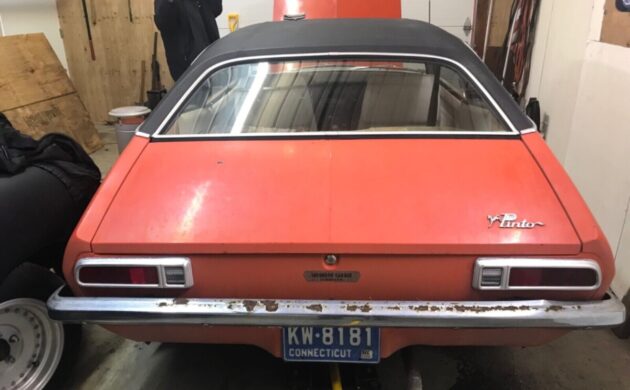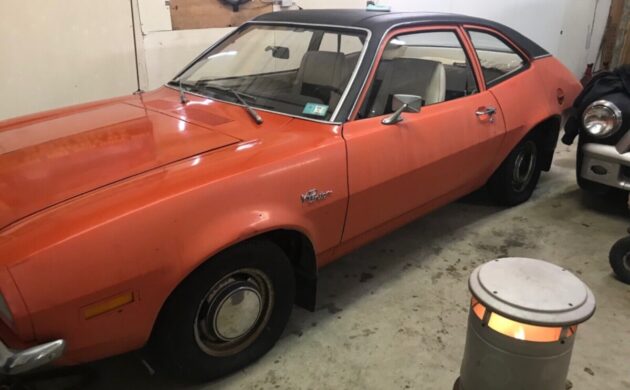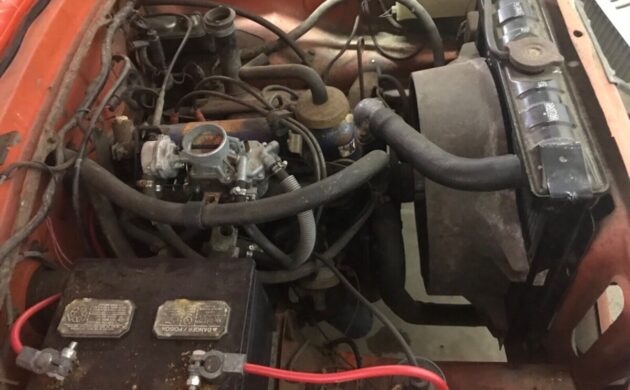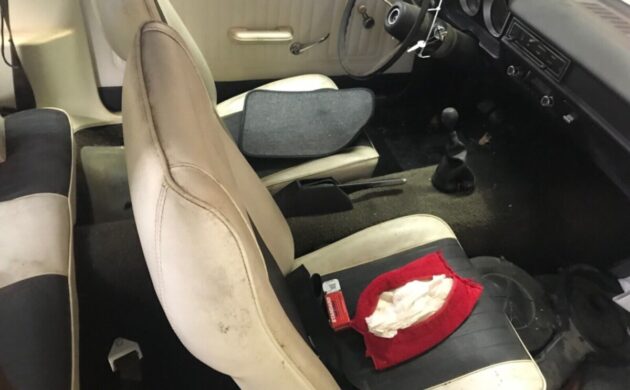It may simply be my sense of humor, but there are times when typographical errors cause me a wry smile. Such is the case with the listing for this 1972 Ford Pinto. The seller refers to it as a “barn fiend” and, given the unfortunate reputation the Pinto developed, it could be closer to the mark than they originally intended! It appears to be a genuine barn or garage find, and its solid nature suggests it could be a straightforward restoration project. The Pinto is listed here on eBay in Hartford, Connecticut. It has received a single bid of $3,500 in what appears to be a No Reserve auction.
I’ve always found it fascinating that Ford elected to develop the Pinto from a clean sheet of paper. It seemed a strange choice when there was so much platform sharing within the company. The easy solution would have been to utilize the European Escort as a starting point, restyling the exterior to suit domestic taste. That approach would have brought the Pinto to market far faster, and considering how much of the Pinto’s drivetrain was derived from that source, the engineering costs would have been far lower. Our feature Pinto is a Two-Door Sedan derivative finished in Bright Red with a Black vinyl top. The exterior photos aren’t the best I’ve seen, but they tell a generally positive story. The car is complete and unmolested, and the paint looks like it might respond positively to a wet sand and polish if the new owner wishes to preserve its survivor status. A close inspection may reveal flaws and defects, but its appearance shows promise. Possibly the best news is this classic’s complete absence of rust. Surface corrosion is visible on the wheels and a few other spots, but no genuine penetrating rust. Some pieces, like the bumpers, would benefit from a trip to the platers, but the glass looks excellent for its age.
The entry-level engine for the 1972 Pinto was Ford’s “Kent” 1,599cc four-cylinder unit that sent its 54hp to the rear wheels via a four-speed manual transmission. That combination doesn’t hold the promise of neck-snapping performance, which is confirmed by a ¼-mile ET of 20.7 seconds. However, Ford saw the aim of the game with the Pinto as an affordable second car that could survive a jaunt down the highway while returning excellent fuel consumption. The 1.6-liter version achieved those aims, being capable of cruising happily at 65mph while returning fuel consumption figures north of 30mpg. This Pinto features the Kent engine, but its condition is unknown. These motors are about as bulletproof as you could ever hope to find, so if it turns but doesn’t run, reviving it may not be difficult. If a rebuild is on the agenda, that is an easy and inexpensive undertaking.
The surprise packet with this Pinto is its interior condition. It is screaming for a deep clean, but the only item that may require replacement is the carpet. The Black and White seat upholstery is free from rips or evidence of abuse, and there is no crumbling plastic. The dash and pad appear untracked, and the same is true of the wheel. There are no aftermarket additions, with the AM radio occupying its rightful place. The equipment levels mean occupants aren’t living in the lap of luxury, but it is all that most owners required in their daily driver.
Automotive history tells us that there are moments when a manufacturer produces the right car at the right time, and sales flow freely as a result. It is no secret that those within the upper echelon at Ford vehemently opposed the Pinto program, but Lee Iacocca used sheer willpower to push through a car in which he held a deep-seated belief. The sales results proved him correct, but the rushed development cycle left some engineers with potential safety concerns that Iacocca chose to ignore for various reasons. These tarnished the car’s reputation when the reality was that it complied with the applicable standards of the day. Once the company relented to the ongoing cries and issued a safety recall, those lingering doubts disappeared. It is no secret that Ford developed the Pinto as a “disposable” compact car, believing that once it served its useful purpose, its final trip would be to the scrapyard. That was the fate of many of the 480,405 vehicles produced in 1972. The survival rate hasn’t been high, and examining market trends reveals that the most highly-coveted vehicles in the current market are the Runabout models. However, a spotless two-door sedan can still command a value beyond $10,000. This one isn’t spotless, but it is an unmolested and rust-free candidate that should represent an easy restoration for the right buyer. Could that person be you?






Thanks Adam. It’s interesting to see the sales data, these were very good sellers in their day. Today, finding one with little to no rust is not easy. Low-option car, yet with a vinyl roof. I don’t remember any factory two-tone interiors at this time, not to say they didn’t exist. Some paint restoration, new bumpers, an interior cleaning, and a set of sporty-looking wheels and tires, and you’d have a fun little errand-runner.
Is that a tire and wheel on the passenger floor?!
It’s the air cleaner, not a wheel or tire.
Of course it is!. Brain fade.
this never gets old……lol
https://www.youtube.com/watch?v=ngtALzDAIcU
It does to me.
I think that’s the missing air cleaner assembly
Back in the late 80’s, my then GF went out and bought a well used Pinto with an auto transmission. I had no idea she bought it until it was in our apartment parking spot. What a gutless piece of ****. It would leave us stranded at least once a month. One time, a lady hit us pretty hard at a stop light. She got out, told us it wasn’t that bad, got back in her car and drove off. Apparently, she knew it was a piece of **** too. My GF then decided to get rid of it and traded it in for a Mustang II, which repeated the cycle of misery.
Did you by chance replace the GF at that point?
He Married Her
The GF left me because I was too “normal” and didn’t bring the chaos that she was use to growing up. I found out 10 years ago that she has 6 kids(!) Bullet dodged.
Lol, Mike!
The vinyl top is an aftermarket addition. Best clue to that, is that chrome trimming on the door window-frames is missing. Higher-trim Pintos got that.
This is actually a find – the Kent engine was quite rare. It wouldn’t make it any fun to drive, but for exclusivity, you have it, there. Most got the Cologne 2.0; and Ford’s people were rushing to clone it in Lima, Ohio as a 2.3. Which was neither as spirited nor as long-lived as the German 2.0.
Why the clean-sheet approach? Ford had dabbled with “captive imports” in the 1960s – the Cortina and the Capri. The Capri was a qualified success, with a limited potential market. The Cortina barely sold and universally rusted. A clean sheet meant, with styling, passenger-room, and the new safety standards (beam guards in doors, among others) made a clean start a seeming-probable savings. Just that one little mistake, the rear axle and the gas tank…
I had several of these, over the years, while I also owned a then-new Escort (1985). The Pinto was far the better car in power and handling. Of course the Escort was better in snow, and got somewhat better fuel economy.
The price on that, seems almost reasonable. IF the next owner doesn’t need major parts or repairs.
Correct on the top. Pintos didn’t come with them back then, if ever.
they did it was the landau top, got the build sheet for one top and trim 175.00
A vinyl roof is listed as an option in the 1972 Pinto brochure. Bright roof drip rail moldings were included, but bright window frame moldings were not. Those were included in the “Accent Group,” which was available stand-alone or as part of the “Luxury Decor Group.”
Look at that intact grill. My 72 Pinto wagon had the 2.0 l German mad motor and 4 speed. I loved that car. 325,000 on it when I parked it. It had the best headlights. That never yellowed out. The money I’ve spent on other vehicles I could have had my Pinto restored to factory condition. 3 times over. It just wasn’t in the cards. Who knows maybe I’ll find one some day.
Make a nice Glidden tribute .. .
I have fond memories of the Pinto, having owned a ‘71 Runabout.(1600cc) Early in our marriage, the wife got the good car, and I pieced together this little Ford. Blue and rust, I patched all of the rust holes with aluminum and pop rivets, valve job, and timing belt, and she was road worthy. Worked out of town at that time, so that car made plenty of 80 mph trips down the highway. Being a hatchback, it was used as a truck as much as a car. When the exhaust and master cylinder failed the same week, I drove it to the junkyard.
If you replaced the timing belt then your car had the 2.0L OHC engine. The 1.6L OHV engine used a timing chain.
Irresistibly cute!
Dad bought one new in 1971.Traded in his VW karman gia for it.Hatchback,1600cc,4-speed.God awful blue.He was a bit of a lead foot and I was often supprised at the way he could get it to move.Two 80 pound bags of concrete in the rear and snow was not an issue.Dad was a stickler for maintenance. Oil,filter lube every 3000 mi.,tune-up every 10k,tire rotations,etc.I can remember being able to “chirp” second and third gears.When the paint started to fade,I brought it into the shop ,and re-sprayed the car for his birthday,the body was clean,no rust.He sold it with 187k on it for $1700 dollars.The guy that bought it kept up the maintenance.I saw him about a year ago,and he no longer uses it as a dailey driver but recently turned 355,000 miles and still going strong!.
“Clean sheet design”? Isn’t it just a bob-tailed Ford Maverick?
Not even close . the only things that are the same are the tail lights . Thats like saying the Vega was just a bob tailed Nova
Someone needs to “street rod” this and put a mustang II front end under it.
Oh wait . . . . . .
They dont have the same front end parts, if that’s what you’re implying
This Pinto is begging for an Ecoboost upgrade with some suspension and brakes too
I think the seller had one of his friends bid on it trying to generate interest in this scrap metal
My Father bought a new S/W model in ’73. Auto & A/C. That was a great little car! Excellent handling and steering. And…the coldest A/C ever seen! It would actually spit out flakes of ice from the dash vents!
Swap in a Turbo Coupe motor trans ( 2.3, 5 speed)and it would be a sleeper
My Dad bought me a ’71 with the 1.6 and a 4 speed. It was a really strange shade of blue. I had no problems with the car. With the exception of it’s lack of power. I traded it a year later. For a ’72 Mach I, nice upgrade.
I always found it funny that Ford was so cheap they used the same exact tail lights on the Pinto and the Maverick.in the early model years.
Cheap ? think about how much money they saved by not making two different lights , from the planning stages to the finished product – It must have been in the millions of dollars saved . .
Even the dash is not cracked! & amazing the front grill is not missing pieces!
I see heater hose going to & from the carb(is that also on the 2000cc OHC motor?) – why didn’t Ford instead use a simple away-from-the-carb mechanical choke thermostat like, for ex., a ’68 chevy 1 barrel used?
I believe the body colored gas cap means that the gas tank recall was not done by Ford, who i believe would install a chrome cap when done.
Are parts still available to do the recall? & if so, would today’s Ford know how to do it? lol
The Pinto recall was Recall #293. I was working for Ford (factory office) when that took place. It was a very interesting period in the car biz.
I’m guessing that the European Escort could not have been assembled in the USA because it was metric. Retooling a US factory to metric specifications is daunting. It’s the reason that the Cadillac Seville was based on the plebian Nova, and not the excellent Opel Diplomat.
The sold price was $3500 which does seem like a lot if it needs extensive work. These earlier models with the small bumpers are good looking cars and if it turns out to not need much work this would be a really great car. I love the colour and styling of this one and would love to have it.
I had a ’79 wagon which was pretty rusted. My feet would get wet when I drove through a puddle. But I really liked it and it was pretty reliable.
My Dad brought the twin to this home to give to my Mom, who never learned to drive stick shift…she looked at it and cried lol.
The car left after 1 evening, was replaced with her 1973 Riviera. That was way better, I think we all agreed.